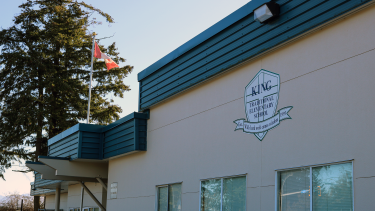
School Name History
Location
28776 King Road, Abbotsford, BC
Opened
1951
The School
Built in 1951, King Elementary School had two classrooms, a furnace room, washrooms and a staff room.
In 1960, a portable classroom was brought in from Dunach Elementary. In 1969, a kitchen, a fourth classroom and a gymnasium were constructed and in 1976, a library was built. During this time, the school had an experimental program for learning about agriculture. Primary students learned about the poultry business and intermediate students learned more about the dairy and horse industries.
In 1984, King Elementary was closed. In 1994, it opened as a traditional elementary school, the first in the district.
Origin of the Name
King Elementary is named for its location on King Road. King Road was most likely named for Edward King, a pioneer who arrived in Canada from Ireland in 1884 and settled in Mount Lehman. He was a farmer, but he may have been connected to the M. B. King sawmill and logging operation on King Road.
He loved the area and immediately started working as a foreman of a road crew, clearing, building, and maintaining roads. He became a well-respected member of the community. He served as cemetery commissioner, a police constable, a police magistrate, a justice of the peace, a deputy returning officer, a school trustee, a reeve of the municipality, and the area’s first tax assessor.
Herbert Baxter King (1879-1956)
Herbert King was born in Dorking, Ontario in 1879 to John and Catharine King. John was a schoolteacher. Around 1901, the family moved to British Columbia, but Herbert remained to earn a Bachelor of Arts degree at Toronto and Queen’s Universities.
Herbert and his wife Minnie, then moved to Vancouver, where he began his teaching career in 1904 at Boys’ Central School in Vancouver.
During World War I, Herbert fought overseas in Europe. He rose to the rank of Major and for the rest of his career, he preferred to be addressed as Major King.
He returned home after the war, where he continued his education at the University of British Columbia. There he earned a Master of Arts degree in 1923. He became the principal of Kitsilano Junior-Senior High school in 1925, where he stayed until 1934.
He was known for an authoritarian, no-nonsense approach to teaching, yet he was progressive in some ways. For instance, he encouraged students to take part in in a variety of programs and allowed boys to take Home Economics classes and girls to take shop. This was unusual for the times.
In 1936, he earned a Doctorate degree in pedagogy (education) and philosophy at the University of Washington. The Vancouver Province noted in his obituary, "He was not only an educator, but one of the best-educated men in the profession."
In 1935, Dr. Herbert was an advisor to the Ministry of Education. He wrote a report called Report on School Finances. He recommended that small school districts be put together into larger, more efficient districts. Through his efforts, the districts of Matsqui, Sumas, and Abbotsford became the first in B.C. to merge into one district. However, it wasn’t until 1947, after a report by a Dr. Cameron, that all of B.C. was reorganized into seventy-four large districts. In 1937, the Ministry of Education appointed Herbert to be the Chief Inspector of Schools for B.C. His written reports covered everything from nursery schools and school lunches to the training of teachers and junior colleges.
In 1945, Herbert retired and moved to a farm in the Fraser Valley near Haney. Although he was no longer working, he was busy. He wrote a book called Solomon Mussallem: A Biography as well as a 1953 series of articles about public schools for the Vancouver Sun newspaper.
In 1956, while on a visit with family in Ottawa, Dr. Herbert King died.
Edward W. King (1851 – 1916)
Edward W. King, born in 1851, arrived in Canada from Ireland in 1884 and settled in Mount Lehman.
He was a farmer, but he may have been connected to the M. B. King sawmill and logging operation on King Road.
He loved the area and immediately started working as a foreman of a road crew, clearing, building, and maintaining roads. He became a well-respected member of the community. He served as cemetery commissioner, a police constable, a police magistrate, a justice of the peace, a deputy returning officer, a school trustee, reeve of the municipality, and the area’s first tax assessor.
Former Matsqui police sergeant and author, Pat McBride, writes in his book, Police, Politicians and Pioneers, that: “A group photograph taken of district pioneers reveals King to have been a big man physically with a full beard and piercing eyes leaving one with the distinct impression that those accused of wrongdoing would not relish the thought of appearing in front of this imposing figure to answer for alleged misdeeds.”
Edward King was an active member of the community until shortly before his death on April 24, 1916. King Road was named after him.
The Abbotsford School District graciously acknowledges the Abbotsford Retired Teachers Association for collecting the histories and stories of our schools as part of their "What's in a name?" 50th-anniversary project.